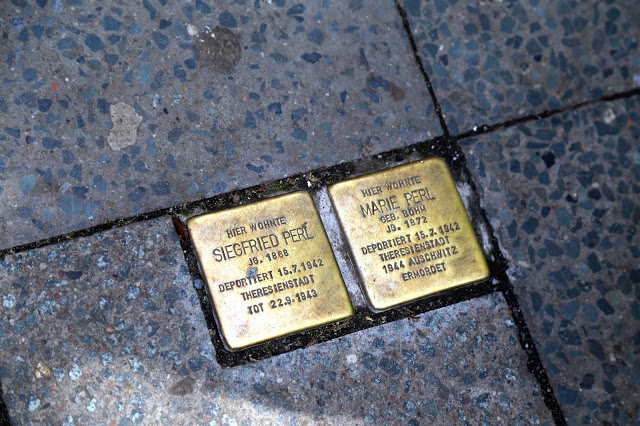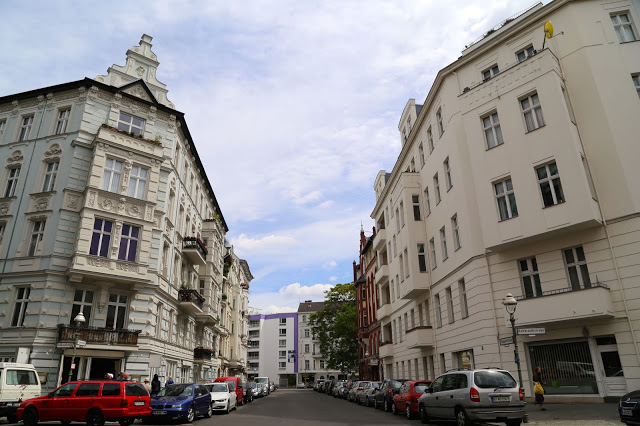




Last time I came to Berlin, in November 2009, I didn’t much like it. I’d booked two supper clubs: one dissipated into thin air, deciding, last minute, that they didn’t feel like doing it, the other turned out not to be a supper club at all but a normal restaurant, an expensive pretentious restaurant at that.
But winter is not a great time to visit Berlin so I decided to give it another chance. My niece is living and working here as a fashion editor on a website and my parents were going to see her so I thought I’d join them.


As I said in my previous post on Berlin, the food is not bad, good value. The portions are enormous and care is taken with ingredients but it’s heavy, leaden fare. German food is all about the meat and Berlin is known for the curry wurst. However Germans also take veganism very seriously, being ethically and ecologically minded. There are no end of ‘bio’ (organic) shops and vegan restaurants.
This time I enjoyed the white asparagus season, something that Germans are fairly obsessed with. “I’ve never known people so enthusiastic and excited about asparagus”, said my niece.
The best thing I ate last time was a pretzel or brezel, which came, miraculously, with a thick seam of butter inside. I’ve spent much of the ensuing five years trying to figure out how it was done. Do they freeze the butter inside? Then, like an arctic roll, it stays solid while the bread bakes? I still haven’t worked it out.
The beer, of course, is good. An average beer order delivers a glass two feet high.

This time I stayed at the Hotel Indigo off Alexanderplatz, the tourist and business centre of Berlin. My room was large and stylish, with a sofa and a glass panelled shower (the latter seems to be all the rage at hotels now but quite often they leak, fortunately this one didn’t), which was easy to use (the amount of times I’ve had to call reception, while naked and dripping with cold water, to find out how the shower works). There was a nespresso style coffee machine and they provided me with a enormous sour cucumber pickle in a can – you know, for those late night pickle emergencies.

Berlin is not beautiful and is built on so large a scale, almost inhuman, it’s not easily walkable. The trip from the airport reveals the anonymous social housing of the east, rapidly erected to house the thousands of homeless after world war two (650k homes were needed). My feeling about Berlin is that you have to live here to appreciate it. People are passionate about Berlin, certainly my niece is, I feel that its charm takes a while to be discovered. Its allure is something interior and hidden to the tourist, like the many courtyard gardens one finds dotted around, sheltering behind tall wide buildings.

My favourite thing this time was going on the Isherwood tour around the Schoeneberg district led by Brendan Nash, an Englishman and cabaret compère, a Joel Grey if you like, who lives in Berlin. Nash gives a fascinating tour on the life of Christopher Isherwood, author of the short stories ‘I am a camera’ and ‘Goodbye to Berlin’ that formed the basis of Cabaret, the stage play and movie. The writer lived for just four years in Berlin, from 1929 to 1933, but this period informed his work for the rest of his life.

The Golden 20s in Berlin
At this time Berlin was the most exciting city in the world, but also very violent. The Weimar Republic declared Berlin as very dangerous: there was nobody in charge. Government changed 17 times during the ‘golden’ or ‘roaring’ 20s. Post-World War 1, there was rampant inflation and street battles between Nazis and communists but Berlin was also tremendously creative and technologically advanced. This was the time of Marlene Dietrich and Fritz Lang in film, Albert Einstein in physics, Bauhaus architecture, Expressionist art, Brecht and Weill in music, Jung in psychotherapy. Paris as a centre for the arts was over.
Berlin was the second largest city in the world, populated by around 4.5 million. (There are only 3.5 million now.)
In terms of social mores Berlin was outrageous, the sex capital of the world. Prostitution was normalised, homosexuality tolerated even though strictly speaking illegal, there was even a special department in the police dealing with those issues. For Isherwood, Stephen Spender and W. H. Auden, Berlin meant boys. Isherwood even stayed for a while at The Institute for Sexology, which campaigned for LGBT rights and was run by Magnus Hirschfeld.

City of Women
Berlin was home to 85,000 lesbians. It had six newspapers and magazines catering just for the lesbian population, 12 social clubs and 2 ice skating leagues. One of the best known lesbian clubs was Le Garconne run by Susi Wanowski, the former wife of a Berlin Chief of Police and lover of Wiemar-era star, Anita Berber. The Amy Winehouse of her day, Anita Berber sounds charismatic: she once pissed on an audience member who wasn’t taking sufficient notice of her performance. She died of drink and drugs at the age of 29.
The character of Sally Bowles was made American and played by Liza Minelli in the film Cabaret. As a show, this is on all the time, always showing somewhere or on tour. Brendan Nash has given this tour to actress Michelle Williams (who played Sally Bowles and in order to give the role originality, made sure she never saw the film Cabaret), the Pet Shop Boys and Isherwoods’ life-long companion Don Bachardy, until Isherwood died in Santa Monica in 1987 at the age of 81.

Berlin in the 30s
This decade-long chaotic party turned dark by the early 1930s as the Nazi party came to power. In 1932, a new government, a Catholic ‘von papen’ coalition started a crackdown on decadent nightlife. Clubs had to close by 10pm. There was a new law banning same-sex dancing. Nightclubs became private members clubs but were frequently raided.
People didn’t dare carry address books as it might implicate their friends. Isherwood burnt his diaries and eventually left Berlin. His later stories were written from memory. He returned in 1952 while writing for a British Sunday newspaper but found the post-war ruined Berlin a very painful memory. He did meet the landlady Fraulein Schroeder who was still living at number 17, the same flat.
Other connections made by Brendan Nash in terms of how inspirational this period was for artists included showing photographs of trans prostitutes who looked exactly like Tony Curtis and Jack Lemmon in ‘Some Like It Hot’. Director Billy Wilder lived in this same area of Berlin.
Marianne Faithfull’s mother Eva von Sacher-Masoch was a ballerina who worked in Brecht and Kurt Weill productions in the area.

Stolpersteine or stumbling stones, a project by artist Gunter Demnig to commemorate the last known address of deported jews.

On this trip I also visited the Reichstag dome designed by Norman Foster. It’s pretty impressive. You must register online to visit and take your passport. Obviously security is very important. You are given a headset with a guided tour that is activated depending on where you are in the dome or on the winding staircase that leads to the top, giving a 360º view of Berlin. We ate in the adjoining restaurant. My dad and my niece were happy with the enormous Weiner Schnitzel and chips but my mum and I ordered something that sounded intriguing: ‘obatzda’, a Bavarian dish that mixes camembert with butter and pretzel. What turned up was this lumpen dumpling? gnocchi? made out of stale pretzels with some strong cheese piped in the centre. It was basically inedible. My mum was so starving she ate it, but I refused. Fortunately they took it off the bill but they didn’t apologise. They said it was “very popular”. Yeah right.

At a loose end that afternoon and interested by the concept of Berlin as a gynocratic lesbian city, my dad noticed there was a lesbian museum open Wednesdays and Fridays. We made our way there, it was in a flat in a building. We knocked on the door and a woman answered. Looking at my dad disapprovingly she said ‘Wednesdays and Fridays are women only’. My dad then said ‘I am a woman. I’m transitioning’.
She didn’t even crack a smile. My dad’s moment as Caitlyn Jenner didn’t work, we weren’t allowed in. (Yes I know this all sounds weird but my dad is a retired journalist and will literally do/say anything to lig his way into a place.) Plus it wasn’t a museum but a library.
You can book Brendan Nash’s Isherwood tour by contacting him on Twitter or on his site Cabaret Berlin.





A riveting post – and your dad sounds like a total hoot! My dad wasn't a journalist but just liked to make stuff up. Until I was about 13 I honestly thought that he had competed against Johnny Weismuller in the Olympic swimming; and he once signed a Japanese schoolgirl's autograph book as "Gary Player", the famous golfer, while on a conference in Tokyo in the early 1970s. Clearly you and I are both blessed with good genes 😉
My mum and dad told me that they met and fell in love when they were in the circus. For years I believed them. So disappointed when I found out it wasn't true.
I think we are blessed with super cheeky genes!
Germans are even crazier about cherries and plums, if you think the asparagus season is intense. Your dad's response at the library was perfect. Thanks for sharing the Stumbling Block project, what a great idea. Oh, and I have a friend whose in-laws really were in the circus; imagine having a grandmother who's a retired trapeze artist!